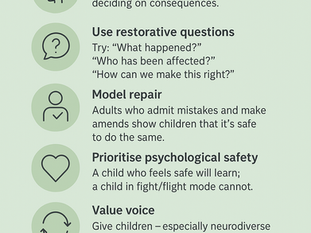


I am big believer in the power of words and saw an interesting post last week on LinkedIn about the power of words to describe others, particulary the deficit attributes that some words hold within the education system and beyond. This prompted me to reflect on what phrases are better to use, that can bring about empowerment, understanding and support.
In education, words are our most powerful tools. They can ignite curiosity, build trust, open doors to imagination, and shape how children see themselves and the world. Among all the phrases we use in classrooms and homes, there’s one that carries quiet but extraordinary power: “I wonder…”
“I Wonder…” – More Than Just Words
At first glance, “I wonder…” might seem like a simple phrase. But beneath its gentleness lies a powerful psychological and pedagogical strategy. It’s declarative rather than directive.... an invitation, not an instruction. When we say “I wonder…”, we’re not demanding answers or control; we’re modelling curiosity, reflection, and open-mindedness.
For children who experience anxiety, emotional dysregulation, or a need for autonomy — such as those with Pathological Demand Avoidance (PDA) profiles — “I wonder…” can be transformative. It removes pressure and replaces it with possibility.
Instead of saying, “You need to calm down,” we might say, “I wonder what might help your body feel calmer right now.”
Instead of, “You should join in,” we can offer, “I wonder if you might like to see what they’re building.”
This subtle shift moves communication away from demand and towards collaboration and emotional safety;essential ingredients for emotional literacy and self-regulation.
Emotional Literacy Through Curiosity
When adults model wondering, we’re showing children how to think aloud, to name feelings, and to explore perspectives.
“I wonder what made you feel that way.”
“I wonder what she might be thinking.”
“I wonder what might happen if…”
These phrases give children language for reflection. They teach empathy and emotional understanding, which are vital parts of emotional literacy that can’t be taught through worksheets or lectures. Curiosity becomes the bridge between emotion and expression.
The Imaginative Power of Wonder
“I wonder…” also opens the door to imagination.
It transports children into new worlds, real or imagined.
“I wonder what it would feel like to stand on Mars.”
“I wonder how bees talk to each other.”
“I wonder what kind of world we’d have if kindness was our main rule.”
Through these wonderings, children develop creative thinking, empathy, and problem-solving skills — the very foundations of STEM innovation and psychological growth. After all, every invention, discovery, and piece of art began with someone wondering.
I wonder what would happen if metal could fly?
I wonder if electricity could light up the night?
I wonder what’s inside the atom?
Those moments of curiosity gave us airplanes, electricity, and quantum physics. Wonder has always been the first spark of progress.
Do We Still Make Time to Wonder?
And yet — do we still allow ourselves, or our children, enough time to wonder?
Modern life moves fast. Classrooms are often driven by outcomes, targets, and assessments. Adults rush from one responsibility to another, rarely pausing to daydream or imagine. Children’s schedules, too, are often packed and structured.
But wonder takes time and stillness. It thrives in pauses — in open-ended conversations, in play, in noticing something new. If we want children to grow into thoughtful, emotionally literate, innovative adults, we need to protect time to wonder.
A Call to Reclaim Wonder
Perhaps it’s time to make �“I wonder…” part of our daily language again — in classrooms, homes, and workplaces.
To wonder is to connect — with ideas, with others, and with ourselves.
It softens conversations, sparks creativity, and nurtures emotional growth.
So next time a child asks a big question, or faces a challenge, or simply gazes out the window — instead of rushing them back to the task at hand, try joining them there.
Say it softly:
“I wonder what you’re thinking about.”
“I wonder what could happen next.”
Because maybe the greatest discoveries — in learning, in relationships, in life — begin not with an answer, but with a moment of wonder.
I wonder how you might use this phrase today....




